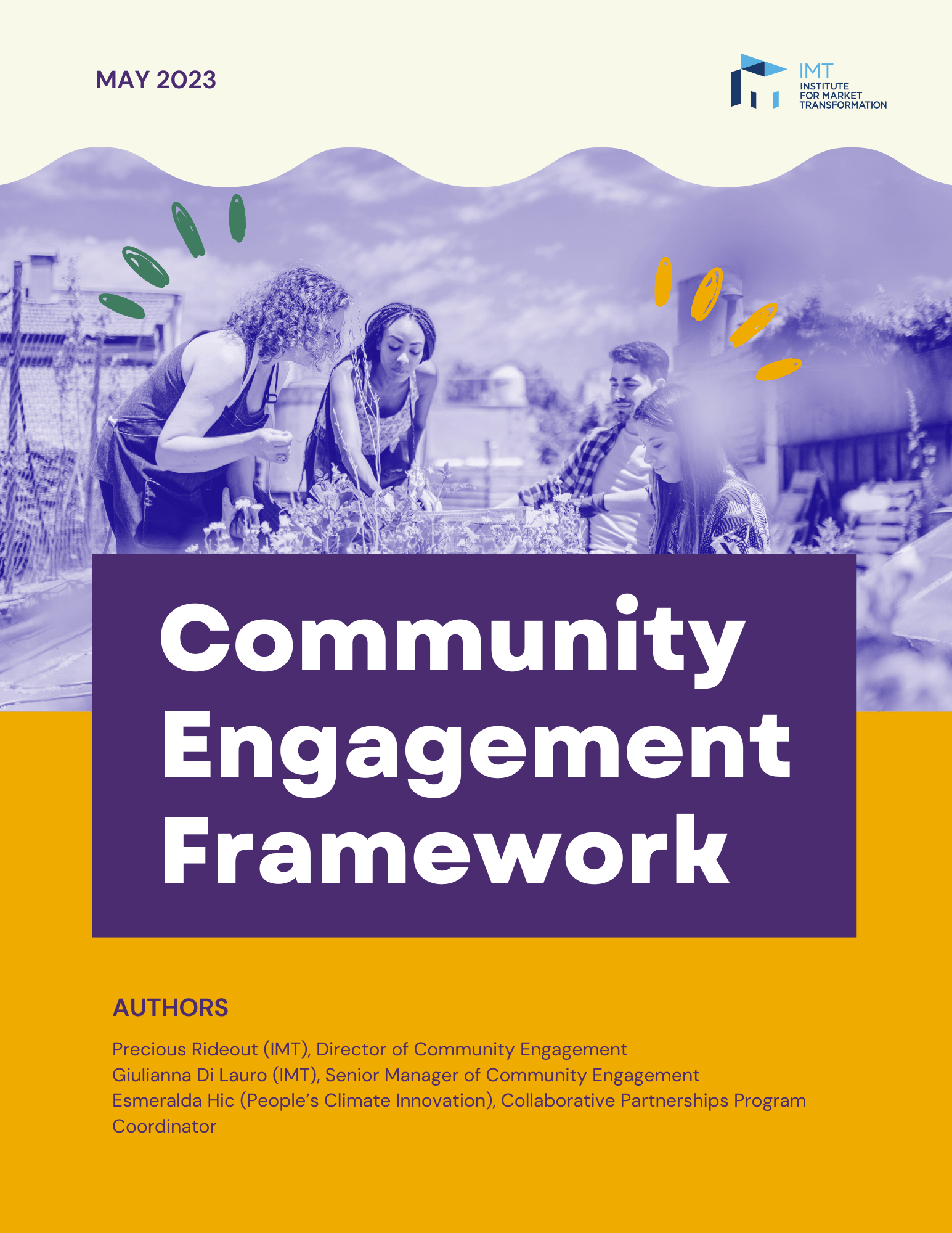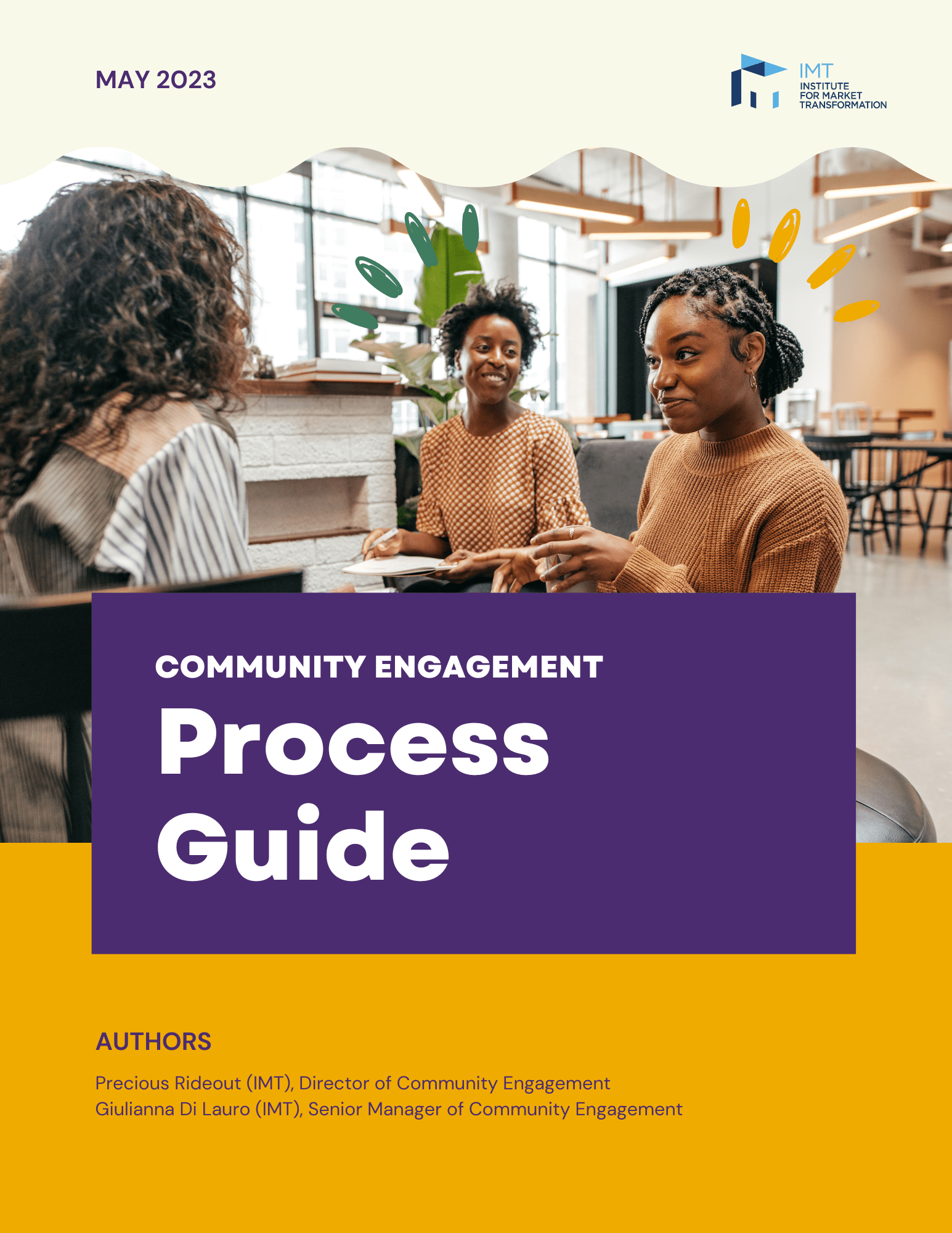Over the last two years, Precious Rideout, Giulianna Di Lauro, and Esme Hic developed a practice that will guide not only IMT’s community engagement work, but the larger organizational strategy around working with frontline communities. Through consistent collaboration with community-based organizations (CBO) that work on a variety of issues—not just building performance—the Community Engagement Team created our new Community Engagement Framework, Process Guide, and Conflict Resolution Guide. The team met over several months to research and establish a strategic plan for helping our government partners meaningfully engage with frontline communities.
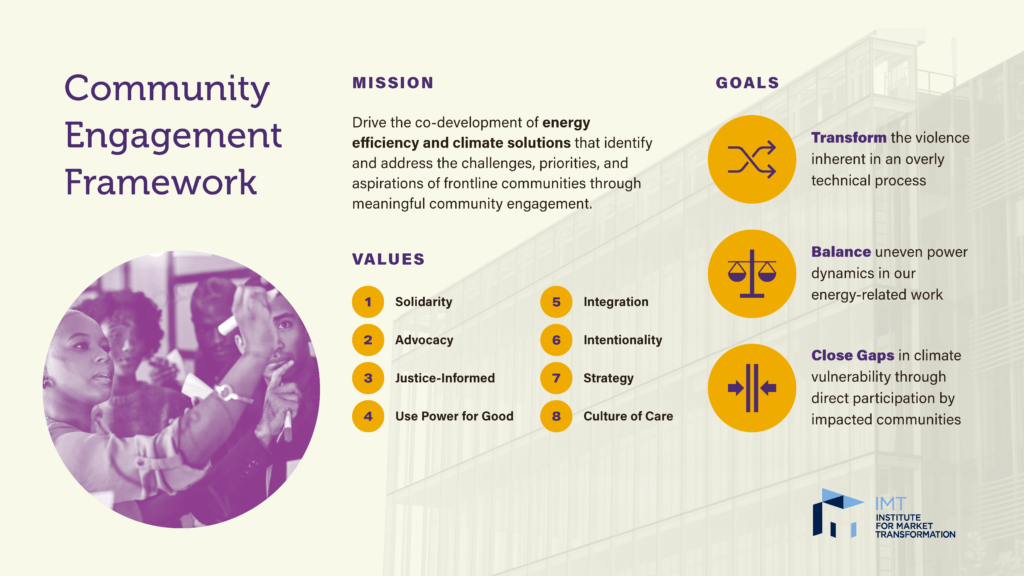
Within many non-profits, community engagement can unfortunately be seen as a separate “project”, as opposed to integrated throughout all of the organization’s programs. Through a restorative justice pilot facilitated by Co-Creating Inclusion throughout Spring 2023, and other internal conversations, it became clear that when the Community Engagement team was first established in January 2021, they were not fully supported. For the launch of these new resources, it’s important to call out that equity has not always been an explicit part of IMT’s ethos. As an organization that has made a name for itself in the buildings policy world, IMT has both intentionally and unknowingly participated in power structures that have levied direct harm against communities. The Community Engagement team has done an incomparable amount of research, storytelling, and internal education that has contributed to a path for IMT that prioritizes solutions rooted in climate justice.
We gathered perspectives from several staff on how they plan on incorporating the lessons from the Framework into their day-to-day. They come from different departments, and have varying levels of experience with the principles that the Framework draws on. Broad strokes though: everyone is committed to challenging themselves, sharing power, and most importantly centering frontline communities.
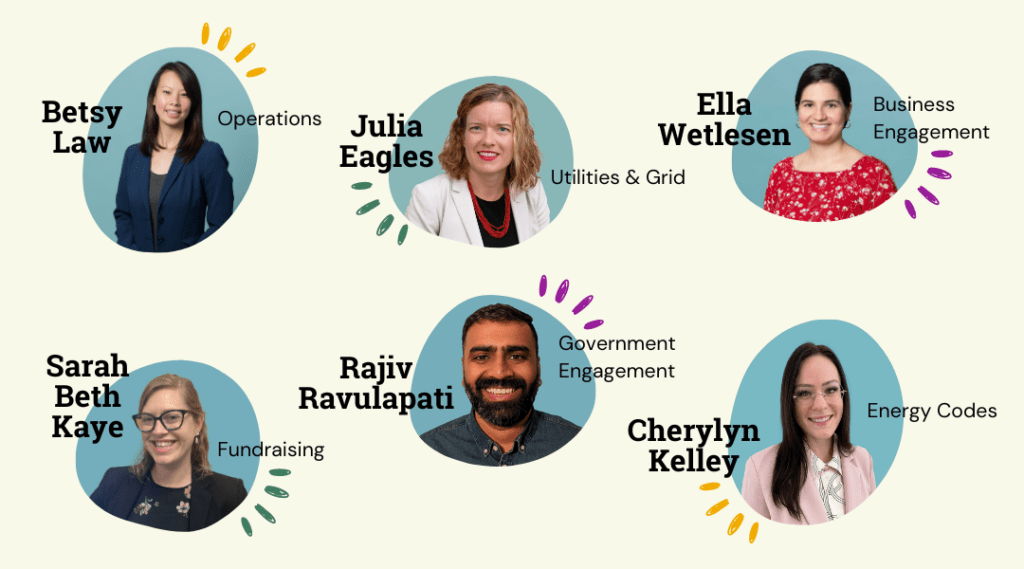
How do you plan to use these resources to inform your work?
Betsy Law, Managing Director of Operations: As part of transforming IMT’s internal operations, we will use the Just Transition lens in the way we build our work culture. Themes like inclusiveness, development of human potential, retain culture and tradition, build what we need now, etc. We’re also designing ways to engage and train staff on how to apply the resources to their work.
Ella Wetlesen, Senior Associate of Business Engagement: I am glad these resources address where IMT has not internally and/or externally centered equity previously—even if well intentioned with a culture of care or passion motivating the work.
Betsy: Internally, we’re changing that by using different forums and time together to address real-life situations and case studies. Updating our onboarding process to include learning around the Framework and definitions. Designing ways to engage the board around the Framework at a high-level so that staff and board are aligned. And perhaps most importantly, we want to ensure that our internal policies and processes embody the principles, values, and spirit of the Framework. This includes creating a conflict resolution policy that also points to the Conflict Resolution Guide. In addition, finding ways to hold staff accountable to applying the Framework, to be embedded in their roles, expectations, and performance evaluation.
Sarah Beth Kaye, Development Manager: These resources will inform how I build and steward relationships between IMT and funders, and between funders and CBOs. When I write applications and narratives, I will cross-check my work against the IMT Community Engagement Values to ensure that I am advocating for transformative solutions, strategizing before acting, and using IMT’s power for good. These values are a good reminder to center community at the core goal of my fundraising work at IMT: building relationships and shifting resources to increase energy efficiency in buildings to save money, drive economic growth and job creation, reduce harmful pollution, and tackle climate change.
How are folks applying this to external-facing programs?
Julia Eagles, Associate Director of Utility & Regulatory Strategy: I see the Community Engagement Framework as a lens for my work, to understand the power dynamics at play in utility regulation. The values provide guidance for my work, something I can check myself against and hold myself accountable to. The Process Guide is rich with examples of how to implement the goals of the Framework. It provides the marching orders to create a Utilities 101 resource, for example. I can see myself using the sample Community Agreements, the MOU template, and the engagement and education processes in Power Sector strategy implementation.
Ella: In my work on the business team, the Framework and Process Guide inform how the policy co-development process then affects the policy compliance resource centers we help build (or high-performance building hubs) with IMT’s mission for equitable decarbonization and policy. The hubs we work with have economic inclusion focuses including workforce development for BIPOC or underrepresented populations, market analysis to understand the barriers people have accessing education and training, and support for under resourced building owners or affordable housing owners which can help prevent displacement and exploitative rent increases to support the benefits of energy efficiency going to all of us.
Even though I am starting out in my career and don’t feel as if I have much institutional power, l now have have frameworks and processes that help me understand ways to facilitate for good in my 3rd party role between stakeholders, and see where our processes are moving towards metrics of equity and where they aren’t hitting the mark.
Rajiv Ravulapati, Senior Manager of Government Engagement: These resources form the bedrock of my work, given the crucial role I play as the primary face representing IMT to numerous jurisdictions. There is one key approach I intend to employ these resources for: the Community Climate Shift (CCS) initiative, a collaborative initiative between IMT and People’s Climate Innovation Center. Within CCS, my responsibility lies in leading the Government Engagement workstream. Governments exist to serve their constituents, and to ensure their best interests are met. Real world, we know it isn’t always like that or realized. I am committed to fostering meaningful engagement with all the governments that CCS seeks to serve. As outlined in our Framework, this entails adopting a person-centered approach that actively encourages and invites communities to purposefully participate in shaping policies, such as the implementation of a BPS policy aimed at advancing justice within their communities.
To manifest this vision, I can use impactful tactics like:
- Secure a grant agreement and memorandum of understanding (MOU) encompassing all place-based initiatives, with explicit commitments from respective governments involved.
- Serve as a facilitator, bridging the gap between communities, community-based organizations (CBOs), and government entities.
- Forge enduring partnerships that empower innovative solutions warranting exploration, such as the establishment and implementation of Community Accountability Boards (CABs).
By embracing these approaches, I strive to tangibly showcase our commitment to fostering inclusive engagement, amplifying community voices, and driving positive change in pursuit of transformation, justice and sustainability.
What communities do you engage with and are accountable to across your projects and responsibilities?

Julia: First are the Community-based Organizations (CBO) who we have partnered with and supported in utility and regulatory engagement efforts: Verde, Coalition of Communities of Color, Community Energy Justice Commenters, etc. I’m also accountable to my coworkers to uphold this Framework, and to call them in on the mission, values, and goals. Finally, my own community where I live, work, and play – the people in my neighborhood and beyond, to whom I am responsible for showing up and giving my time and talents.
Rajiv: The communities to which I am presently accountable are Chicago, New Orleans, Kansas City, and the sprawling Los Angeles metropolitan area. However, with the potential approval of our pending federal grant proposals and the achievement of our fundraising goals, this accountability will extend even further. As we progress, our ultimate aspiration is for the Community Climate Shift (CCS) initiative to serve as a transformative model that IMT endeavors to scale across the entire nation.
Imagine a future where the success of CCS paves the way for a nationwide movement, revolutionizing how communities engage with climate action and resilience. Together, we can create a ripple effect of positive change, with the lessons learned and accomplishments achieved in these initial communities inspiring and empowering others in cities and regions across the country. The vision of a sustainable and resilient future should know no bounds, and through the expansion of CCS, we can truly transform the landscape of climate action, leaving an indelible mark on peoples’ lives.
Betsy: I do not typically work with frontline communities as part of my immediate responsibilities. However, as we build partnerships, I may be providing support on the operations and admin area of work. For example, the operations team oversees the administrative procedures around contracting and re-granting.
Sarah Beth: As a fundraiser, I am accountable to all frontline communities IMT collaborates with because it is my role to ensure they are appropriately compensated for their work. IMT’s commitment to fund CBOs for sharing their technical and lived experience expertise, for leading and contributing to energy efficiency efforts, and toward collaborating with IMT to reach mutual goals is a critical part of our work. I am accountable to both funders and CBOs to ensure that funds are distributed equitably and timely.
Which goal resonates with you the most, and why?

Betsy: “Transform” resonates with me the most as the first step. You need to build trust in order to carry out an inclusive policy-making process. This includes alignment on common language, expectations as a team/individual, and common understanding of social impacts.
Julia: Yes, like the utility regulation and decision-making is technical and inaccessible, and part of my role is demystifying that space through the power sector work.
Betsy: I see this as a culture shift within the energy industry. This goal can be both challenging and rewarding as you work towards building a collaborative team to do the work. But, we need to design and find solutions that meet the needs of those most impacted in order to truly build equitable policies—it’s a win-win for everyone.

Sarah Beth: “Balance” speaks to the opportunity for IMT to leverage our positional power and technical expertise to leverage and redistribute funds from federal and philanthropic partners to frontline community CBOs.
Rajiv: With over a decade of experience in grassroots organizing and working for city government, both my professional and personal life have exposed me to the intricate workings of power dynamics and the historical context of collaboration. Or lack thereof between government and communities, let’s be real. What really strikes a chord within me is the essence of collaboration embedded in this goal. I envision myself as a bridge, a developer who nurtures the fertile ground for collaboration to flourish across diverse sectors and among a multitude of stakeholders. It sounds aspirational and flowery, but I mean this with total conviction.

Ella: “Close Gaps” resonates with me the most because in the high-performance building hub process I work within, CBOs shape which support programs the Hub builds whether that’s a under resourced building support program, vendor matchmaking program, or expanded education.
Cherylyn Kelley, Manager of Building Energy Codes & Policy: Energy codes are technical and kind of a niche subcategory of energy policy that not many folks, outside of builders and special interest groups, get into. There is so much opportunity to bring awareness to the benefits of energy codes—it’s one piece of the puzzle that communities can leverage to reduce energy use and costs, improve resilience and indoor air quality, and by extension reduce climate impacts and improve quality of life.
Despite this, the technical nature and the long, frequently nebulous processes to develop or adopt new energy codes often deter community involvement—even if energy codes can go a long way to support local goals. That’s why closing the gap is important to me. We need more direct participation in energy code processes by those who are impacted by them, and everyone is impacted by an energy code in one way or another. I can help with this through education. I want to provide communities and their local leaders with resources that will help make the energy code more digestible to enable broader involvement in code adoption processes. I think being able to provide community-specific resources and analyses based on their goals and needs can help communities enact a code that will maximize its benefits while ensuring the energy code doesn’t inadvertently harm frontline communities. Having an energy code that is reflective of local goals is the best way to set buildings—and, more importantly, those who reside in them—up for long term success.
In your work, how can you leverage IMT’s institutional power to advocate and implement solutions that defer to communities?
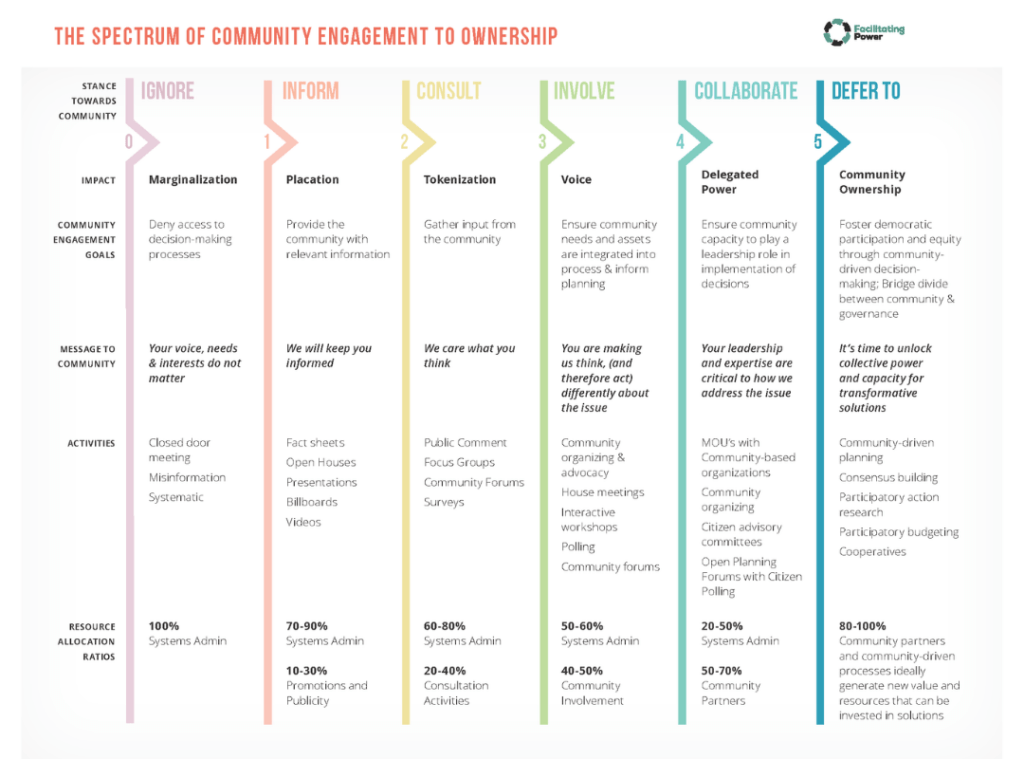
Cherylyn: IMT is fortunate to be a well-known and respected organization in the building decarbonization space. One of the best ways we can leverage this power is to lead by example and hold the organizations we work alongside to the same high standard.
Rajiv: Yeah, and by embracing the Spectrum of Community Engagement to Ownership, we can work so that communities have a genuine voice in shaping the decisions and actions that directly affect them.
Sarah Beth: Like IMT can use our power to open up new streams of unrestricted funding that can be owned and allocated directly by frontline communities to serve their own needs and priorities. IMT’s positional and institutional power opens doors to opportunities to meet funders and grow relationships (that may include financial support) in ways that grassroots CBOs do not have access to. It is our obligation to not only redistribute funds, but to directly connect grassroots CBOs to funders, collaboratively apply for new funding opportunities, and to take on the technical burden of application navigation and submission.
Betsy: It’s also important to transform IMT’s people management policies and processes to ensure staff have the training and support they need to apply the framework to their work (how to conduct a power analysis, etc.). We’ll continue to communicate expectations org-wide and hold staff accountable to this work.
What are some concrete strategies you’ll be using moving forward?
Cherylyn: We should be calling attention to energy code processes that are exclusionary, and provide recommendations for improvement where feasible, such as providing virtual access to code adoption meetings in locations where it is not yet offered. I can provide technical support to communities that enables them to participate in code processes that impact them, and educate on why community involvement is important to the process. Providing the tools and knowledge necessary to informed participation in code development and adoption processes is essential to developing solutions that meet community needs.
Julia: Very similar to energy codes, we want to support CBO participation in regulatory decision-making processes, uplifting and translating community priorities into technical recommendations. We can recommend changes within utility regulatory forums/proceedings/processes that advance distributional, procedural, and structural equity. I’ve really enjoyed supporting the Community Engagement team on projects like the Orlando Climate Forward campaign, informed by community solutions with IMT providing technical assistance.
Ella: I leverage IMT’s institutional power in our policy compliance resource center process by listening to the priorities communities have already, and having those concerns shape the programs that are built. I also aim to use our expertise to advocate as much as possible to nonprofit partners or city partners we have to not reface community advocacy or work that’s been done, but to be a partner in equitable decarbonization.
Rajiv: In my work, I recognize the importance of leveraging IMT’s institutional power to advocate for and implement solutions that prioritize community deference. Here are some ways I can employ IMT’s institutional power to empower communities:
- Amplifying Community Voices: I can utilize IMT’s platform and resources to elevate the voices of community members, ensuring their perspectives and needs are heard and considered. This can be achieved through various means such as hosting community forums, creating gap analyses, and actively seeking input from marginalized and underrepresented groups.
- Co-Creating Solutions: IMT’s institutional power can be harnessed to foster genuine collaboration between communities and decision-makers. By establishing inclusive partnerships and engaging in co-creation processes, we can collectively develop solutions that address community needs, aspirations, and priorities. This approach ensures that solutions are not imposed from the top-down but are shaped by the collective wisdom of those directly affected.
- Resource Allocation: As an organization with institutional power, IMT can play a pivotal role in advocating for equitable resource allocation. This involves actively supporting policies and initiatives that direct funding, technical assistance, and resources to communities that need them the most. By advocating for and implementing inclusive resource allocation strategies, we can help level the playing field and empower communities to implement their own solutions.
- Building Capacity: IMT can leverage its institutional power to invest in community capacity-building initiatives. This includes providing training, mentorship, and technical assistance to community leaders and organizations, enabling them to actively participate in decision-making processes and take ownership of solutions. By building local capacity, we foster self-sufficiency and ensure sustained community ownership and resilience.
- Advocacy and Policy Influence: IMT’s institutional power can be used to advocate for policies that promote community deference and ownership. This involves actively engaging with policymakers, sharing community-driven success stories, and promoting policy changes that prioritize community engagement, collaboration, and empowerment. By influencing policy at local, regional, and national levels, we can create an enabling environment for community-centered solutions.
By consciously leveraging IMT’s institutional power in these ways, we can foster a culture of community deference and ownership, ensuring that communities are at the forefront of decision-making and that solutions truly reflect their unique aspirations and needs.
Ella: This quote from Lilla Watson sums it up for me: “If you have come here to help me, you are wasting your time. But if you have come because your liberation is bound up with mine, then let us work together.”

